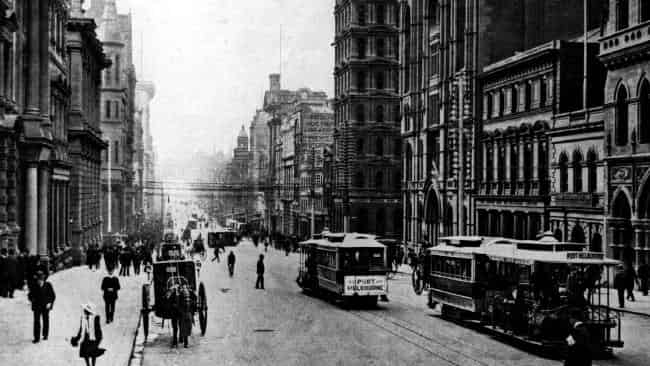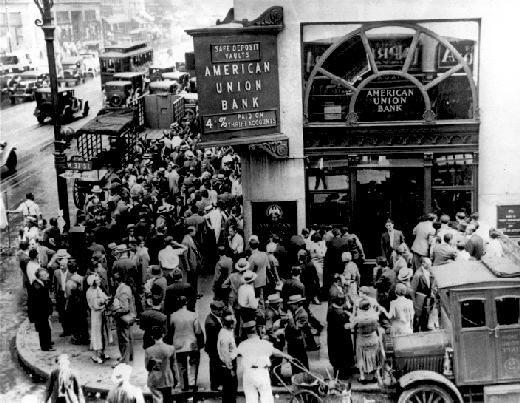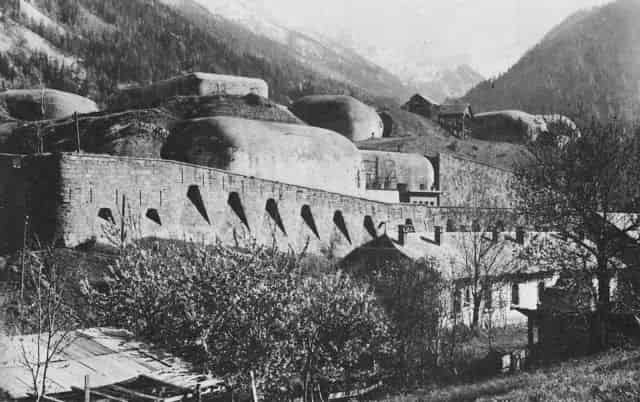Australian Regional Building, Chapter 5: The new suburbs
Chapter 5: The new suburbs
Author: Alistair Knox
The outbreak of the First World War marked the end of the pioneering days. The old gave place to the new with startling rapidity. The present writer was two years old when Germany marched into Belgium. In 1914 the British Expeditionary Forces moved into France to the strains of 'It's a Long way to Tipperary'. Each day, stories of German atrocities grew worse. Stirring martial tunes filled the streets, men were enlisted everywhere. Maiden ladies of doubtful age were not beyond presenting white feathers here and there. All this was lost on my tender years; only one memory remains. I was fascinated by sailing ships. How many times my father carried me down to the beach on his shoulders on the hot summer evenings I do not know, but it seemed to be every night! Whenever he did, I could see what, to me, was the edge of the world. It was the opposite side of Hobson's Bay. The square-rigged sailing ships berthed at Nelson pier, Williamstown. When tied up, the yards were set at all sorts of angles. Their changing pattern in the purple sky made a lasting impression on me. The next summer, I searched for them in vain. They were gone, never to return. The war swept what remained of them from the sea at one sweep.
It was at that time that taxis began to make appearances in some numbers in the streets. At the conclusion of hostilities, the transport methods were rapidly changing from horse-drawn lorries to motor vehicles. For some years, the breweries kept using Clydesdales to haul the barrel-stacked lorries through the streets. The horses were gaily plumed; and their peak-capped drivers, as rotund and ruddy as Sam Weller Sr, recalled vanished days. In Melbourne the cable cars still trundled down Collins Street. Every self-respecting male citizen was able to board and alight when they were moving at full speed.
 Cable trams running up Collins Street in 1910. The first cable tram started operating in 1885. Picture: HWT Library.
Cable trams running up Collins Street in 1910. The first cable tram started operating in 1885. Picture: HWT Library.
The grip man, always a man to envy, as he threw the grips with skill and timing at the corners or applied the shiny brakes at stops. The tram bell, about a foot in diameter, and its surprisingly melodious 'ding ding' gave warning that the brakes were fully applied; but it would be some time before the dummy and its attached car could stop. There was a sense of belonging in Melbourne in those days. To ride down Collins Street on a fine afternoon on the front of the dummy was indeed something to remember. Or to take a run along St Kilda Road and watch the jinkers that were still around in twos and threes, with their eager horses racing the cable cars as they quietly pursued the fairly even tenor of their way. Adminders to hold on whilst rounding curves were prominently lettered in half a dozen places. 'Refrain from expectorating' was a popular notice in all means of public transport. Spittoons were still to be seen in some railway compartments. The railways supplied two waiting rooms: one for smokers, and one for ladies. But this division between male and female ran into the age of the Charleston, the Black Bottom, and the Blues. It was seen no more. Quite a number of gentlemen with powerful muscles continued to make outings on push bikes on Saturday afternoons. I had an uncle who used to set out in apple-catcher trousers and a neat cap set at the correct angle. Each month they became a little more apprehensive as the volume of motor traffic increased. The railways had become electrified ground! The popular activity of running to the station in the morning and leaping onto the slowly moving steam train as it glided out of the station became memories in a moment. The tempo increased in all departments of everyday existence. Regulations became more significant. One no longer knew everyone else in one's suburban area.
The grand old radial roads that led in and out of Melbourne remain, unchanged. Royal Parade, St Kilda Road, Victoria Parade, Flemington Road, Albert and Dandenong Road. Three chains wide, with the trees meeting overhead, and the row and terrace housing in some streets and the crazy Victorian wedding-cake buildings in others, still retained a human scale. Even Collins Street was two- and three-storeyed in character, and flanked with green trees. The lacy ironwork had become old-fashioned, but it exuded a sense of homely comfort. In Carlton, the balconies were being filled in with extra boarding rooms, and Drummond Street was becoming down at heel. It was parochial, but it was us. We may have criticised it, but underneath we had a sense of belonging and being needed.
 Crowd at New York?s American Union Bank during a bank run early in the Great Depression.
Crowd at New York?s American Union Bank during a bank run early in the Great Depression.
Suburbs like Hartwell, Tooronga, and Glen Iris were enjoying a building boom, with the average young marrieds. The current building style was Spanish Mission. White stucco wall, capped with Cordoba tiles, a palm tree or two, sometimes even a cactus, and sundry piercings in the brick walls. And then the bursting of the boom. The Jazz Age ran down like a broken cuckoo clock. The stocks fell in Wall Street, and millionaires fell out of multi-storeyed buildings, or shot themselves in their expensive offices. All the building in the world ground to a stop. Then came the dole and its consequences. Stories of starving and near starving, and the shape of the cities of the world took a short rest. The skylines remained static for some years.
Hitler's rise to power sent the building trade into action fairly slowly once again. A certain number of factories were being erected. The building techniques were much the same as they had always been, although reinforced concrete was being used to an increasing extent. Domestic-building methods showed no appreciable change. It was stumps and bearers and Baltic or hardwood weatherboards for timber buildings. Brick buildings were still regarded as being much superior to timber constructions. Every up-and-coming council had its brick 'areas' clearly marked. It was considered very 'non you' to live in a wooden house. They were strictly for people who lived north of the Yarra, and who worked in factories or were carpenters, manual workers of one kind or another. Spinsters, retired people, and a small, well-established section of the community were the only members of society who did not lose face by living in timber. The rising costs of brick construction in the stringent 1930s made popular the brick veneer. It was an invention that has proved invaluable, to the sanctimonious inhabitants of Melbourne's suburbs. What a solace for that wide group of face-savers in the domestic scene! Brick veneer means a brick skin over a wood-walled building. From the outside, it is impossible to distinguish it from a solid-brick house. North Balwyn faced the rising costs with a new heart. It enabled the intending owner to purchase cream bricks instead of red, and still save money. And what social standing those creams gave your house! They 'set it off'. It was also the era of the 'landscape window'. This contrivance was a three-light affair. It consisted of two small double-hung sashes on each side, with a square of fixed glass in the centre. The eaves were small, and gables disappeared altogether. The lower-priced houses were distinguished by the hip roof. The ridge line of these houses generally wandered from here to there in a most disconcerting manner, giving evidence of the battle facing the home-planner to resolve the layout of the house. New words were appearing in the planner's vocabulary. 'Dining angle', 'kitchen nook', and 'dinette' were the most popular. It was a time of eating in small places. Open planning began to make some impression on the best-informed circles. It was cautiously open. But the whole of building progress between the wars was gradual and hesitant. Wrought iron and ponderously tiled bathrooms were status symbols. Until the 1930s, painting schools for artists were strictly traditional, and realist. The Pianola was the popular musical instrument of the day, and radio was still heard through loudspeakers which were shaped like hunting horns.
 Red tiled suburban roofs
Red tiled suburban roofs
From the air, the suburbs presented a sea of red terra cotta-tiled roofs. Fibrolite was almost unknown, and galvanized iron was relegated to sheds and factories. The lovely slated roofs of the nineteenth century were frequently taken off and replaced with red brick tiles.
Gardens consisted of weedless lawns, herbaceous borders, and concrete drives. Saturday afternoons were full of the whirr of the lawn-mower. You could literally gauge the physical effort exerted by the man pushing it! The air was redolent with the smell of burning leaves and the throaty snipping sound of secateurs. Standard roses and Lorraine Lee climbers grew together in the front garden. The popular trees were the Lombardy poplar, the Roman cypress, and the silver birch. Hardy perennials came and went with the seasons. The mighty Don Bradman filled the sporting headlines. Altogether, it was at time of parochial isolation from the rest of the world. We used to refer to Japan and China as the 'Far East'! In the world outside, Mussolini was pouring castor oil down the throats of those who did not like his methods and who said so. Germany first suffered the horrors of a raging inflation, and then fell under the spell of Adolph Hitler and the Third Reich. Even more serious seemed to be the increasing power of communism. It grew fat on the festering sores of poverty. It came only as a mild surprise when the students at Oxford declared in a manifesto that they would not fight for king and country in any circumstances. Pacifism was the order of the day. By turning our backs on war, we were going to avoid it. I still remember the morning when I picked up the newspaper announcing Hitler's march into the Rhineland. I did not know the implication of his act. I was only vaguely aware that the assurance the editorial gave did not add up to the facts. It was an age of 'well-informed circles'. This inner coterie pronounced a series of perpetually contradictory statements over the disaster. For years the country moped along, living from hand to mouth. Food, even in this land, was short in many houses. Throughout the 'civilised' world, stockpiles of food products that would not bring a price were being ceremoniously burnt, while thousands starved. And in the meantime, the central powers and Japan were feverishly arming. On looking back, it is incredible that so little was done about this situation. Apparently we could not afford it. We could not afford to build, either. We merely had to tighten our belts until some well-informed member of some well-informed circle decided it was time to get going. It eventuated that the well-informed did not include Neville Chamberlain, the British prime minister in 1938. He came back from Munich with an agreement with Hitler and Mussolini which he said would give peace in our time. The cost of this senile statement was the annexation of Czechoslovakia by Germany.
It did bring an inkling to Australians who had over the years taken little interest in politics that platitudinous statements issued from Canberra were not enough. If, however, a voice was raised against the Government policy, it automatically turned out to be a member of the Communist party who had raised his voice.
Right up to 1939, when the impending holocaust broke, the Heidelberg of Griffin and the impressionist painters remained unchanged. Only the little buildings and others used when they were creating the Australian Impressionist School were demolished. Otherwise all slept, bathed in the dreamy sunlight of another century. The pine-tree boundaries of the orchards in Templestowe seemed to grow darker and stronger than ever. The 1930s was a decade which spent its time sleeping.
 Section of the Maginot Line
Section of the Maginot Line
The stark awakening of 1939 was turned to horror and infinite alarm in 1940. The cost of the somnambulistic 1930s reaped the whirlwind of the German blitzkrieg. The impregnable Maginot line fell with hardly a shot fired. France collapsed. Britain lay panting, naked, and wounded on the shore below the cliffs of Dover. The miracle of that survival was to be felt later, in the building of postwar years. But it was not to prove a strong national revival. The peerless speeches of Churchill deserved a better fate in the eventual peace. Why is it that man can only see truthfully in the midst of war and disaster? Is it not that he has lost the capacity to believe in adventure for its own sake? The twentieth century in Australia suddenly found itself separated from the sweat and tears, the toil and hope, of its pioneering decade by two world wars that changed the whole character of life.
The technological age became the real hub of the building revival. It was more important than man. The feelings of man and, consequently, the real needs of man. It became something like the peacetime manifestation of the German Panzer divisions of ten years earlier, when they charged through Europe to change it forever. The world became mechanically minded. Nothing that was made by hand was thought to have the power of survival in the new age of atomic theory and practice.
< Previous Book
< Previous Chapter
:
Next Chapter >
Next Book >
